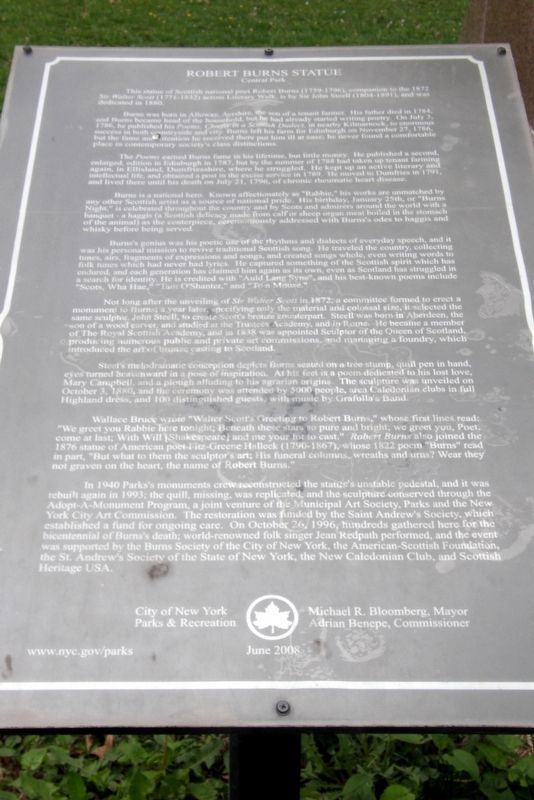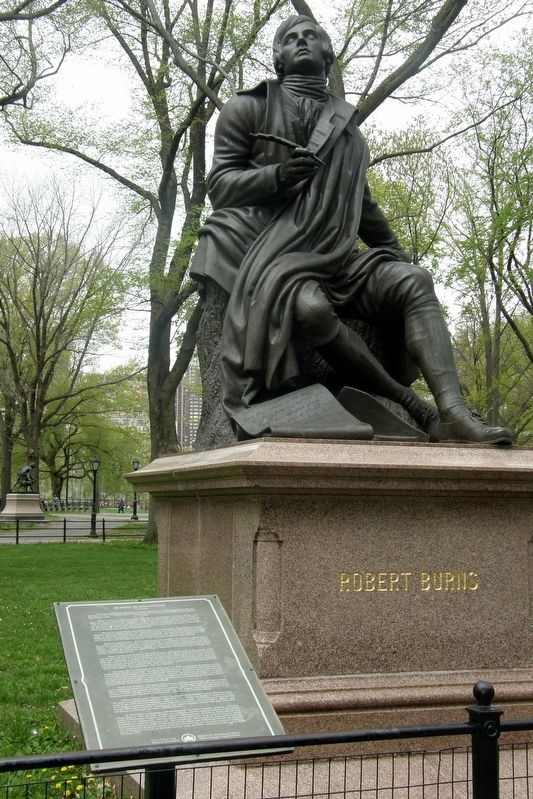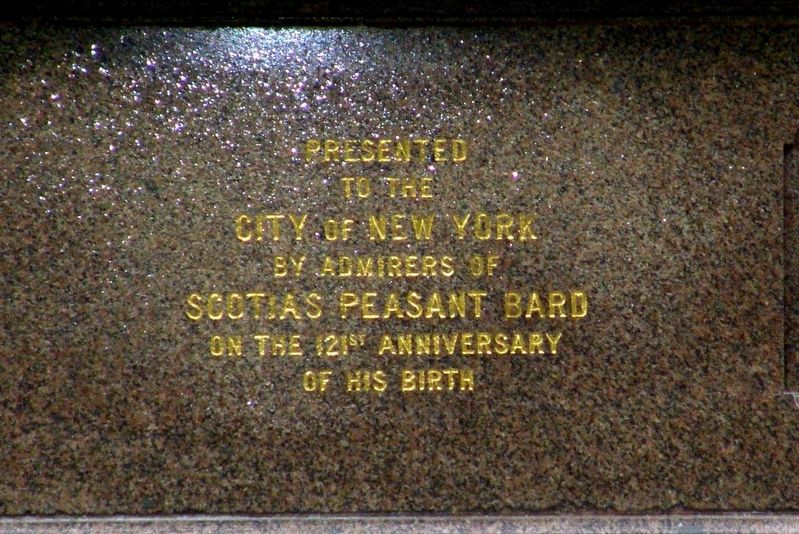Central Park West Historic District in Manhattan in New York County, New York — The American Northeast (Mid-Atlantic)
Robert Burns Statue
This statue of Scottish national poet Robert Burns (1759–1796), companion to the 1872 Sir Walter Scott (1771–1832) sculpture across Literary Walk, is by Sir John Steell (1804–1891), and was dedicated in 1880.
Burns was born in Alloway, Ayrshire, the son of a tenant farmer. His father died in 1784, and Burns became head of the household, but he had already started writing poetry. On July 3, 1786, he published his Poems, Chiefly in a Scottish Dialect, in nearby Kilmarnock, to enormous success in both countryside and city. Burns left his farm for Edinburgh on November 27, 1786, but the fame and attention he received there put him ill at ease; he never found a comfortable place in contemporary society’s class distinctions.
Poems earned Burns fame in his lifetime, but little money. He published a second, enlarged, edition in Edinburgh in 1787, but by the summer of 1788 had taken up tenant farming again, in Ellisland, Dumfriesshire, where he struggled. He kept up an active literary and intellectual life, and obtained a post in the excise service in 1789. He moved to Dumfries in 1791, and lived there until his death on July 21, 1796, of chronic rheumatic heart disease.
Burns is a national hero. Known affectionately as “Rabbie,” his works are unmatched by any other Scottish artist as a source of national pride. His birthday, January 25 (“Burns Night”), is celebrated throughout the country and by Scots and admirers around the world with a banquet - a haggis (a Scottish delicacy made from calf or sheep organ meat boiled in the stomach of the animal) as the centerpiece, ceremoniously addressed with Burns’s odes to haggis and whisky before being served.
Burns’ genius was his poetic use of the rhythms and dialects of everyday speech, and it was his personal mission to revive traditional Scottish song. He traveled the country, collecting tunes, airs, fragments of expressions and songs, and created songs whole, even writing words to folk tunes which had never had lyrics. He captured something of the Scottish spirit which has endured, and each generation has claimed him again as its own, even as Scotland has struggled in a search for identity. He is credited with “Auld Lang Syne”, and his best-known poems include “Scots, Wha Hae,” “Tam O’Shanter,” and “To a Mouse.”
Not long after the unveiling of Sir Walter Scott in 1872, a committee formed to erect a monument to Burns. A year later, specifying only the material and colossal size, it selected the same sculptor, John Steell, to create Scott’s bronze counterpart. Steell was born in Aberdeen, the son of a wood carver, and studied at the Trustees Academy, and in Rome. He became a member of The Royal Scottish Academy, and in 1838 was appointed Sculptor of the Queen of Scotland, producing numerous public and private art commissions, and managing a foundry, which introduced the art of bronze casting to Scotland.
Steell’s melodramatic conception depicts Burns seated on a tree stump, quill pen in hand, eyes turned heavenward in a pose of inspiration. At his feet is a poem dedicated to his lost love, Mary Campbell, and a plough alluding to his agrarian origins. The sculpture was unveiled on October 3, 1880, and the ceremony was attended by 5,000 people, area Caledonian clubs in full Highland dress, and 100 distinguished guests, with music by Grafulla’s Band.
Wallace Bruce wrote “Walter Scott’s Greeting to Robert Burns,” whose first lines read: “We greet you Rabbie here tonight; Beneath these stars so pure and bright; we greet you, Poet, come at last; With Will [Shakespeare] and me your lot to cast.” Robert Burns also joined the 1876 statue of American poet Fitz-Greene Halleck (1790-1867), whose 1822 poem “Burns” read in part, “But what to them the sculptor’s art; His funeral columns, wreaths and urns? Wear they not graven on the heart, the name of Robert Burns.”
In 1940, NYC Parks’ monuments crew reconstructed the statue’s unstable pedestal. It was rebuilt again in 1993; the quill, missing, was replicated; and the sculpture conserved through the Adopt-A-Monument Program, a joint venture of the Municipal Art Society, NYC Parks and the New York City Art Commission (now the Public Design Commission). The restoration was funded by the Saint Andrew’s Society, which established a fund for ongoing care. On October 26, 1996, hundreds gathered here for the bicentennial of Burns’ death; world-renowned folk singer Jean Redpath performed, and the event was supported by the Burns Society of the City of New York, the American-Scottish Foundation, the St. Andrew’s Society of the State of New York, the New Caledonian Club, and Scottish Heritage USA.
Erected 2008 by New York City Parks and Recreation.
Topics and series. This historical marker is listed in this topic list: Arts, Letters, Music. In addition, it is included in the NYC Parks series list. A significant historical date for this entry is January 25, 1872.
Location. 40° 46.204′ N, 73° 58.344′ W. Marker is in Manhattan, New York, in New York County. It is in the Central Park West Historic District. Marker can be reached from The Mall. The marker is in The Mall of Central Park in the section known as Literary Walk. Touch for map. Marker is in this post office area: New York NY 10019, United States of America. Touch for directions.
Other nearby markers. At least 8 other markers are within walking distance of this marker. Sir Walter Scott (a few steps from this marker); William Shakespeare (within shouting distance of this marker); Columbus (within shouting distance of this marker); Women's Rights Pioneers Monument (within shouting distance of this marker); William John Liebig (about 300 feet away, measured in a direct line); Welcome to the Dene Slope (about 300 feet away); Balto (about 400 feet away); Transverse Road #1 (about 500 feet away). Touch for a list and map of all markers in Manhattan.
Also see . . .
1. John Steell's 1880 Robert Burns Statue - Central Park. Daytonian in Manhattan website entry (Submitted on September 12, 2023, by Larry Gertner of New York, New York.)
2. Central Park / Robert Burns. Official NYC Parks description. (Submitted on April 12, 2020, by Larry Gertner of New York, New York.)
Credits. This page was last revised on September 12, 2023. It was originally submitted on September 14, 2017, by Larry Gertner of New York, New York. This page has been viewed 284 times since then and 18 times this year. Last updated on September 15, 2017, by Larry Gertner of New York, New York. Photos: 1, 2, 3. submitted on September 14, 2017, by Larry Gertner of New York, New York. • Bill Pfingsten was the editor who published this page.


